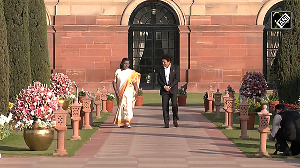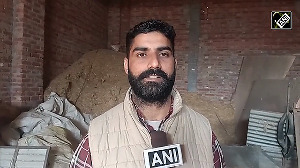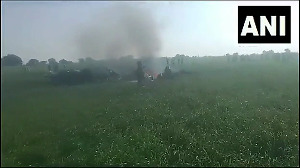
The Bush administration's decision to sanction a fleet of F-16 aircraft for Pakistan in March still raises hackles in New Delhi, even though Washington has hastened to promise India much more in armaments.
Yesterday, Gopal Ratnam, a defense writer based in Washington, DC, revealed why US officials believe that India has already won the game, which Pakistan would find it difficult to just stay in.
In the second part of the series, Lahore-based journalist Amir Mir glances at the the American decision to sell F-16s to Pakistan from Islamabad's point of view.
The Bush administration's decision to sell F-16 strike fighter aircraft to both India and Pakistan indicates the level of trust and credibility Pakistani President General Musharraf has built with his US counterpart, President George W Bush, since he joined the US-led war on terror after 9/11.
Diplomatic circles in Islamabad see the supply of the much-delayed fighter aircraft as a personal favour to an individual (General Musharraf) on whom the US relies heavily to pursue its international agenda. These include efforts to hunt down Osama bin Laden and attempts to neutralise Iran's nuclear capability.
Advanced F-16s and the upgrading of its existing F-16 fleet has always been on the Pakistani wish-list.
On March 25, President Bush notified Congress of his intention to clear the sale of F-16 aircraft to Pakistan.
US proposal for F-16 to Pak: India disappointed
Lockheed Martin, the company which makes the planes, can start negotiations with the Pakistan government on the sale if there is no opposition from the US Congress within a month.
Under the deal, the US would sell new F-16 fighter jets to Pakistan and not those that were manufactured for Islamabad in the late 1980s. The Pakistan Air Force is likely to purchase about 70 F-16s of the latest Block 50/52 C and D type models costing about $2.4 to 2.8 billion.
Teams from Lockheed Martin would visit Pakistan and reciprocal visits would be made by top officials to US to work out modalities and finer details of the deal. Pakistan defence ministry sources said part of the cost would be met from the five-year, $3 billion US assistance for Pakistan committed by Washington in 2003, half of which is for military purchases.
The final delivery process could take a minimum of two years after the made-to-demand manufacturing process starts.
Pakistan is looking for Block 50/52 C and D type aircraft, with a capability to carry nuclear weapons, including single-seaters and dual-seaters, with advanced avionics and weapons upgrades.
Pakistan already has F-16s A&B versions (28 As and 12 Bs) built at Lockheed's Fort Worth plant in 1985. But the scheduled delivery of its second batch of 60 F-16s was suspended in 1990 after then US President George H W Bush refused to certify that Pakistan was not toying with a nuclear-weapons option.
The US had imposed sanctions on Islamabad under the Pressler amendment that blocked all military sales to nations said to be clandestinely developing nuclear weapons.
'F-16 to Pak saved 5,000 US jobs'
At that time, the PAF had received 40 F-16s under a deal called 'Peace Gate.' Deliveries under Peace Gate-I included six F-16s comprising two F-16As and four F-16Bs and follow-up support of $156 million. Deliveries under Peace Gate-II included 34 F-16s of both F-16A and F-16B models and a follow-up support of $1 billion.
The F-16s which never made it to Pakistan included some 71 negotiated as part of PG-III and PG-IV deals. Of the total 71 under the negotiated PG-III and PG-IV, the first ten under the PG-IV were delivered while the delivery of other 60 F-16s was stopped by the US.
At the same time, Pakistan had to pay for the storage of the planes at the US Aerospace Maintenance and Regeneration Centre.
After joining the US-led war against terror, General Musharraf had pleaded with President Bush to give the F-16s to Pakistan as a gesture of the newly-established friendship, but the administration balked. The US had apprehensions that the F-16s could be used in a possible Indo-Pak war at a time when tension between the two was at an all time high.
But after the award of the Major Non-NATO Ally status to Islamabad in June 2004, Pakistan became the fourth Muslim country after Egypt, Jordan and Bahrain to have long-term strategic and military relations with the US.
The status made Pakistan eligible for priority delivery and access to defence articles, allowed stockpiling of military hardware, purchase of depleted uranium, cooperation in defence and research programs and loan facilities.
Analysts believe Pakistan has acquired added importance in the eyes of President Bush after his re-election in November 2004, given the fact that he has shifted his focus from capturing Osama bin Laden to containing Iran's nuclear capability.
US dismisses India's concerns on F-16 sale
The US intelligence community thus requires a presence in Pakistani territory to collect intelligence about Iran's nuclear installations and to mount any possible operation against Tehran.
The US also required his cooperation in the International Atomic Energy Agency's ongoing investigation against Iran on a uranium enrichment facility constructed by it.
During a spot inspection, IAEA experts found that some of the centrifuges in the Iranian facility contained highly enriched uranium, thus giving rise to a suspicion that Iran might have already started clandestinely producing weapon-grade enriched uranium.
The Iranian government has strongly denied producing weapon-grade enriched uranium, claiming that it bought the centrifuges second-hand from an outside party (most probably Pakistan) and that traces of the enriched uranium found in the Iranian facility might have come from the supplier of the centrifuges.
The IAEA has been demanding for over a year now that Pakistan should hand over some of its centrifuges and a sample of its enriched uranium for comparison with those found in Iran.
However, Pakistan was reluctant to oblige the IAEA till March.
Since early March, Western media reports have been quoting IAEA officials in Vienna as saying that Pakistan had relented and agreed to hand over some of the centrifuges from its Kahuta enrichment facility.
Just days ahead of US Secretary of State Condoleezza Rice's March visit to Pakistan, Pakistan Information Minister Sheikh Rashid Ahmed admitted that 'the father' of Pakistan's nuclear programme, Dr Abdul Qadeer Khan, was the one who had sold centrifuges to Iran.
The statement came out of the blue. Later, a government spokesman tried to downplay it by saying that the minister had merely stated what was already known. It was a lame explanation at best because the minister ended up officially confirming for the first time the extent of Dr Khan's help to Iran.
The demand for handing over of centrifuges reportedly figured during the March 16-17, 2005 Islamabad talks between Condoleezza Rice and Musharraf. In a subsequent television interview on March 24, Musharraf announced he was considering sending some nuclear centrifuges to Vienna for inspection.
'To end the issue once and for all, we want to send nuclear centrifuges to Vienna for inspection and the matter is under consideration,' Musharraf said. But he did not indicate whether he would also agree to send a sample of enriched uranium from Kahuta.
Within 24 hours of Musharraf's statement, Bush notified the US Congress of his decision to clear the sale of F-16s to Pakistan, giving credence to rumors in the diplomatic circles that the F-16 lollipop was a reward for the general's cooperation against Iran.
US firm offers 'exclusive' F-16s to India
Though Pakistan's Foreign Minister Khurshid Kasuri rubbished such charges, few believe that that Musharraf's statement about Pakistan planning to hand over some obsolete centrifuges to the IAEA and the immediate announcement of the Bush administration agreeing to sell F-16s to Pakistan are a coincidence.
Diplomatic sources in Islamabad even expect Musharraf wriggling out of the project for the construction of a 2,775-km long gas pipeline from Iran to supply gas to Pakistan and India, in order to please the United States.
The proposed pipeline, costing $4.16 billion, originates in Asaluyeh, Iran, on the coast of the Persian Gulf near the South Pars fields, enters Pakistan through Khuzdar (one section goes to Karachi on the Arabian Sea coast), and the main section traveling on to Multan and extends further to New Delhi.
Islamabad and Tehran had been discussing technical aspects of the project and were expected to sign a memorandum of understanding by the end of March.
But while the US wants India and Pakistan to build a gas pipeline, it proposes that instead of Iran it should come from Turkmenistan -- through Afghanistan and Pakistan -- to India. The US had conveyed its desire for the construction of the gas pipeline to India even before the US secretary of state visited New Delhi in March and acknowledged that the US did not want India to buy gas from Iran.
The Rediff Interview/US Secretary of State Condoleezza Rice
The amount of time Condoleezza Rice spent discussing the Iranian gas pipeline with Indian leaders left nobody in doubt that blocking the project was high on her visit. But that was barely surprising considering how keen the US is to keep global crude networks under its grip.
The State Department has already explained that the sale of F-16 to both the nuclear neighbours fit into the broader strategic relationship across South Asia.
'We are looking to improve security and prosperity and improve development of the entire region as a whole through an integrated program of engagement,' Adam Ereli, the State Department deputy spokesman, told a news briefing in Washington a day after the US decision on F-16s was made public.
The Bush administration has also attempted to sweeten the bitter pill for India by mooting its desire to promote India as a major world power with an eye to match the growing economic and military might of China, and through the offer of state-of-the-art F-16s and even F-18s to India, with 18 aircraft to be immediately delivered, and another 108 to be assembled in India via a technology transfer agreement.
Similarly, while the US has offered to Pakistan F-16s on a 'take-and-fly-away' basis, it had proposed India licensed production of F-16s in India.
With India, the US is developing strategic ties; with Pakistan, it requires turning the country around and keeping it secure.
Its relations with India cover a much-broader ambit -- political, economic and military; with Pakistan, the primary aim is to monitor the country and keep it on the track where General Musharraf guided and put it since September 13, 2001.
Pakistan also, in this policy thrust, becomes a very important state in the war against terror. This necessitates give-and-take within a framework in which Indo-US relations do not undergo any unnecessary and avoidable friction.
In any case, the idea is to improve American ties with the two nuclear-armed neighbours while also nudging them to improve their own ties and become less suspicious about each other's motives. The policy has worked fairly well for the US until now.
While the US move is seen as politically bolstering Musharraf at home, it will help the Pakistani military ruler counter those who believe the US was unreliable as it had walked away after the first Afghan War.
In the 1980s, when Islamabad was fighting alongside the US to evict the Soviet occupation troops in Afghanistan, it had agreed to sell 28 F-16 planes to Pakistan. But as soon as the Soviet forces withdrew, the F-16s sale was suspended.
Yet, the September 2001 terrorist attacks in New York and Washington and the subsequent decision by the Bush administration to attack the Taliban-led Afghanistan once again turned Pakistan into a frontline state.
If the decision not to sell F-16s to Pakistan resulted from the Soviet withdrawal from Afghanistan followed by the collapse of the USSR and the end of the Cold War, the decision to sell the same aircraft to Pakistan has much to do with the ongoing American war on terror.
Musharraf's photograph: Andreas Solaro/AFP/Getty Images
Image: Uday Kuckian





 © 2025
© 2025